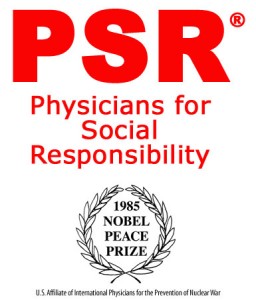Air Quality
Eagle Ford Expose Reveals Weakness in Gas Air Pollution Inventories and That’s Bad News For DFW
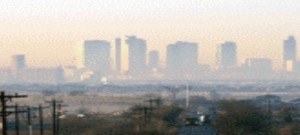 By now, many of you have seen the massive eight-month act of journalism that the Center for Public Integrity committed in describing the situation in the Eagle Ford shale play in South Texas. It's probably the most comprehensive look at what it's like to live in Texas fracking hell that's been published, and it rightly got distributed far and wide.
By now, many of you have seen the massive eight-month act of journalism that the Center for Public Integrity committed in describing the situation in the Eagle Ford shale play in South Texas. It's probably the most comprehensive look at what it's like to live in Texas fracking hell that's been published, and it rightly got distributed far and wide.
Along with the now-familiar litany of acute human health effects from gas mining – nosebleeds, headaches, skin rashes, respiratory problems – the article also talked about the smog-forming pollution cause by the thousands of small, medium-sized and large gas facilities that invade a shale play. Together they represent a formidable air quality challenge.
Centering on the Buehring family of Karnes City, the piece lists the inventory of gas mining infrastructure surrounding their home. Besides the 50 wells within two and a half miles, they also host,
"….at least nine oil and gas production facilities. Little is known about six of the facilities, because they don't have to file their emissions data with the state. Air permits or the remaining three sites show they house 25 compressor engines, 10 heater treaters, 6 flares, 4 glycol dehydrators and 65 storage tanks for oil, wastewater and condensate. Combined, those sites have the state's permission to release 189 tons of volatile organic compounds, a class of toxic chemicals that includes benzene and formaldehyde, into the air each year. That's about 12 percent more than Valero's Houston Oil Refinery disgorged in 2012.
Those three facilities also are allowed to release 142 tons of nitrogen oxides, 95 tons of carbon monoxide, 19 tons of sulfur dioxide, 8 tons of particulate matter and 0.31 tons of hydrogen sulfide per year. Sometimes the emissions soar high into the sky and are carried by the wind until they drop to the ground miles away. Sometimes they blow straight toward the Buehrings' or their neighbors' homes.
That's 331 tons a year of smog-forming Nitrogen Oxides and Volatile Organic Compounds released from just a small number of square miles in the Eagle Ford. Just two more collections of facilities like that would equal all the smog pollution coming from the TXI cement plan tin Midlothian – North Texas' single largest smog polluter. It's no wonder then that a San Antonio Council of Governments air pollution model found that Eagle Ford smog pollution would make it impossible for the Alamo City to comply with the new 75 parts per million federal ozone standard.
Moreover, that 331 tons a year figure is just what can be discerned by reading Texas' archaic permitting records. The Center's reporters do a real public service in identifying the loopholes and gaps the system encourages that hide the true air pollution numbers,
Texas' regulatory efforts are also hamstrung by a law that allows thousands of oil and gas facilities—including wells, storage tanks and compressor stations—to operate on an honor system, without reporting their emissions to the state.
Operators can take advantage of this privilege—called a permit by rule, or PBR—if their facilities emit no more than 25 tons of VOCs per year and handle natural gas that is low in hydrogen sulfide. Two employees in the TCEQ's air permits office—Anne Inman and John Gott—estimate these PBRs could account for at least half of the hundreds of thousands of air permits the agency has issued for new or modified oil and gas facilities since the 1970s.
Operators with this type of permit aren't required to file paperwork backing up their self-determined status, so the TCEQ has no record of most of the facilities' locations or emissions. A chart generated in 2011 by the office of then-TCEQ executive director Zak Covar says the permits "Cannot be proven to be protective. Unclear requirements for records to demonstrate compliance with rules."
Big operators sometimes get a PBR for each component of a facility. Each might be under the 25-ton-per-year threshold that would require a more rigorous permit, but the facility as a whole could emit more than that.
The TCEQ refers to the practice as the "stacking of multiple authorizations," and the memo from Covar's office said its use "means that protectiveness and compliance with the rules cannot be demonstrated."
But of course that doesn't keep Rick Perry's TCEQ from saying everything is all right. As per usual, officials want to the results of stationary monitors in the region to assure residents that nothing unhealthy is being breathed-in.
"[M]onitoring data provides evidence that overall, shale-play activity does not significantly impact air quality or pose a threat to human health," agency spokeswoman Andrea Morrow wrote in an email."
But in this case, the region, covering a huge area from East Texas to the Rio Grande, has only five such monitors, "all positioned far from the most heavily drilled areas."
Moreover, that's just the holes in the permitting process itself. What about when a facility is a bad actor and has an "emission event' or "upset" where more than the permitted amount of pollution is released for hours or even days at a time?
"The number of emission events associated with oil and gas development doubled between fiscal years 2009 and 2013, from 1,012 to 2,023. The amount of air pollutants released into the Texas air during these events increased 39 percent."
A gas processing plant in McMullen County, in the southwestern portion of the Eagle Ford, reported 166 emission events last year, almost one every other day. From 2007 through 2011, the Tilden plant, owned by Regency Energy Partners of Dallas, discharged 1,348 tons of sulfur dioxide during such episodes. That's more than 30 times the amount it was legally allowed to release during "normal" operations.
Marathon waited three months to report a 2012 incident at its Sugarhorn plant near the Cernys and Buehrings. It released 26,000 pounds of VOCs in 12 hours, 1,000 times more than allowed under its air permit.
But what has this got to do with DFW smog? Everything. Besides the Barnett Shale play entering and enveloping the Metromess from the West, we also have the Eagle Ford and Haynesville shale plays to our South and East – upwind of DFW during our eight-month "ozone season." There are now as many wells in close proximity to DFW up wind as downwind.
Right now, as part of the new anti-smog plan for DFW being drafted by the TCEQ, the state is "re-calculating" oil and gas air pollution emissions and you'll never guess how that's working out – TCEQ is using industry advice to lower their estimates from last time around. At a January 31st meeting of what's left of the local air planning process, the state presented its new study that it's using to revise the considerable amount of air pollution coming from leaks and releases from condensate storage tanks in the Barnett and elsewhere. As of 2012, these releases are estimated by TCEQ to be only 25% of what they were in 2006. See how well that works out? And this number will be plugged into the computer model that then estimates how much of that air pollution turns into smog.
Instead of getting real world numbers for compressor stations, the TCEQ is now using a fomula based on local production and horsepower to estimate emissions, and guess which way this new technique is sending the numbers?
TCEQ is doing everything it can to make sure that the oil and gas air pollution numbers are as low for this new anti-smog plan as they can make them without breaking out laughing. Why? To prevent the call for new controls on these sources, even though everyone knows they're adding to the problem. Oil and gas emissions are the one air pollution category in DFW that's grown in volume since 2006, while others, like the Midlothian cement plants and East Texas coal plants, and even cars, have all gone down. Meanwhile, DFW ozone averages are higher then they were in 2009. Many of us don't think that's a coincidence. But the ideologically-driven TCEQ can't afford to admit the obvious – not while Rick Perry is running for President.
Compare the TCEQ strategy in DFW with the reality described in the Center for Public Integrity's reports from the Eagle Ford Shale and you have two completely different pictures of the amount of air pollution coming from the oil and gas industry. Which do your trust more – the official calculations coming out of Austin, or the secret memos and field reports uncovered by the reporters?
If what's happening in South Texas is also what's happening in the shale plays in and around DFW – and there's no reason to think it isn't – then the volumes the TCEQ is plugging into its anti-smog plan for the Metromess are off by large factors. That in turn could spell doom for the plan, due to be submitted to the EPA by July of 2015 – a little over a year from now.
This is why it's important for citizens to have their own computing power with their own modeling capabilities. It's the only way to call TCEQ's bluff that it's using all the right information to draft its new clean air plan to EPA. Without the technical know how to be able to look over TCEQ's shoulders and reveal its "GIGO"strategy, our lungs are hostages of Rick Perry's political ambitions.
The next North Texas appearance by TCEQ staff to explain how its estimating – or not – the air pollution from oil and gas industry sources as well as every other source – is scheduled for 10 am on Thursday, April 17th at the HQ of the North Central Texas Council of Governments located at 616 Six Flags Drive – right across the street from the Amusement Park. We need citizens to come out and ask pointed questions about the TCEQ effort to keep us from being taken on another ride to nowhere. Anyone can come and ask questions of the presenters – it's an open forum – and indeed it's the ONLY opportunity citizens have to actually quiz the TCEQ about the process. Please mark the date and try to be there. Meetings usually last until 12 noon or so. They think you're not paying attention. These numbers and quotes from the Public Integrity Center piece gives you lots of ammunition to prove otherwise.
Testimony From Magnablend Explosion Trial: “Heavy Metal Lids Flapping Up and Down”
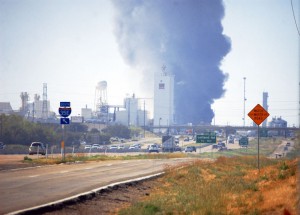 Do you remember the Magnablend explosion in Waxahachie in October of 2011? It quickly enveloped the entire facility and created clouds of black smoke that wafted all the way to Dallas. Run-off from the water used to control the fire killed hundreds, if not thousands, of fish in a near-by creek.
Do you remember the Magnablend explosion in Waxahachie in October of 2011? It quickly enveloped the entire facility and created clouds of black smoke that wafted all the way to Dallas. Run-off from the water used to control the fire killed hundreds, if not thousands, of fish in a near-by creek.
Magnablend was not a chemical manufacturer. It mixed chemicals already made into new combinations for different industries, including the oil and gas industry, pool companies, etc. It did this not all that far from central Waxahachie.
This last week saw testimony about the conditions leading up to the fire in a trial where Magnablend (now called Lifoam Industries) employee James Barron alleges he suffered injuries from inhalation, including brain damage, headaches, balance problems and shortness of breath. His doctor diagnosed him with encephalopathy and high cortical dysfunction caused by exposure to carbon monoxide fumes in the fire.
Following his doctor's diagnosis, Barron's attorney cross-examined Brent Asbill, a supervisor on duty the day of the fire, and asked him to describe the situation that lead to the explosion and fire.
"Asbill said on the day of the accident there was a new chemical tank to blend the product in that had no cooling jacket, thermometer of adequate suppression. Asbill said he was able to get a thermometer installed on the tank by maintenance personnel but the other concerns he reported to his supervisor. His supervisor then made a call to another boss to explain Asbill’s concerns, but Asbill was told to proceed with blending the product. Cole asked if Magnablend had required him to read any of the material safety data sheets that were on file. Asbill said no."Cole then asked Asbill to describe come of the conditions, once he knew something in the blending process appeared to be wrong. Asbill said the heavy metal lid on top of the tank was flapping up and down which indicated that tank had pressure. The vapor produced from the chemical reaction made it appear as if it was raining inside the building. Also electrical equipment started to arc and short out."
Despite these conditions, and evacuation still wasn't ordered until after the explosion. Testimony by other employees and contractors indicate that there was only a single fan providing any kind of ventilation for the blending operation.
Testimony from the trial shines a harsh light on two or three realities in the chemical business. First, it's employees who are often on the front line of health effects from these kinds of facilities, whether through routine exposure of chemicals or catastrophic accidents. But Magnablend had no union looking out for employees, and you'd be hard-pressed to find any union representation in the chemical industry outside the traditionally-union friendly Gulf Coast. Could such an accident have happened in a union shop? Sure. But it's less likely because more boxes have to be checked and there are more rules designed to protect the employees.
Second, the rules and regulations on paper governing an industry don't always mean much in the day-to-day operation of a facility like this – not huge enough to warrant official concern from EPA or OSHA most of the time, but large enough to cause a huge ecological and public health threat if something goes wrong. Industry can't be "over-regulated" if current regulations are not being enforced.
Finally, despite assurances, things can and do go wrong in the field. Whether it's on a fracking rig, a chemical plant, or a cement kiln, human beings find it difficult to be perfect 100% of the time and when you're dealing with unforgiving processes or technology that leave little room for error, things will sometimes go horribly wrong.
That's not an argument to ban such industrial activity, but it's a compelling argument to locate these kinds of facilities away from people.
New Studies Link Air Pollution To Diabetes and High Blood Pressure in Pregnancy
 Sometime during the 1990's it became evident that air pollution was more than just a threat to your lungs. Studies begin linking bad air with brain disorders, heart attacks, and hormonal disruption. This pool of research is now very deep and this month got a little deeper with publication of studies linking air pollution to Type 2 Diabetes and high blood pressure.
Sometime during the 1990's it became evident that air pollution was more than just a threat to your lungs. Studies begin linking bad air with brain disorders, heart attacks, and hormonal disruption. This pool of research is now very deep and this month got a little deeper with publication of studies linking air pollution to Type 2 Diabetes and high blood pressure.
From the University of Maryland comes a report that concludes air pollution increases inflammation of the heart which leads to diabetes when combined with a high fat diet – the kind so many Americans are still eating. Sedentary mice were fed the high-fat diet and then forced to breath Beijing-like levels of air pollution. Exposure to that bad air, primarily high levels of particulate matter, increased the likelihood of the mice developing diabetes by 2 to 4 times, and increased he severity of the disease as well. But hey, we're in America where the air is so much cleaner than China's, right? According to Dr. Sanjay Rajagopalan, Professor of Cardiovascular Medicine at the University of Maryland,
"….there have been at least 15 studies that have actually extended these observations of experimental models to large populations, and some of these have been done obviously in North America where we live, you know, in a relatively clean environment from an atmospheric standpoint thanks to regulation put together by Congress in the 1970s..but despite that even with the levels you’re exposed to with this continent we still see continuing associations between inhaled particulate matter content and susceptibility to type 2 diabetes.
Meanwhile, researchers at the University of Florida found that exposure to four air pollutants, including two specific types of fine and coarse particulate matters, sulfur dioxide and carbon monoxide, may be more toxic to pregnant women than breathing in cigarette smoke.
"Fetal development is very sensitive to environmental factors," said Xiaohui Xu, an assistant professor of epidemiology in the university. "That is why we wanted to do this research. Hypertension (high blood pressure), in particular, is associated with increased morbidity and mortality, causing a lot of problems for the mother and fetus, including preterm delivery."
Xu and his colleagues matched up 22,000 births in Jacksonville Florida in 2004-2005 with EPA pollution data. After controlling for other risk factors like income and exposure to smoking, they concluded that exposure to air pollutants throughout the first two trimesters of pregnancy increased women's risk of developing one of these conditions as much or more as smoking itself.
So how much influence do environmental factors have on modern health? Dr. Rajagopalan says a lot:
"…there’s a growing body of data that’s suggesting that whether it’s water or air or things that you eat, the packages that food is packed in…all of these things have ever so slight effects on your susceptibility to a number of chronic diseases. And these are things that are the reality, but are really the primary prevention measures where if you took care of these issues, you might not have problems to begin with. So these are easy solutions, clearly when you start to think about it, but also equally complex in terms of implementing at a societal level, because it takes so many different stakeholders to agree and to make these changes, you know, it tends to be a lot more complex.
Yep. We noticed.
Can a Council Whose Majority Voted for the Trinity East Permits Now be Expected to Defend the City’s Denial?
 As you might have heard by now, forlorn natural gas operator Trinity East has sued the City of Dallas for denying the three permits it was seeking to drill along the Trinity River in Northwest Dallas by the Irving border. Claiming breach of contract and even fraud, the company is saying it's owed millions of dollars above and beyond the $19 million it spent on leases for the three sites.
As you might have heard by now, forlorn natural gas operator Trinity East has sued the City of Dallas for denying the three permits it was seeking to drill along the Trinity River in Northwest Dallas by the Irving border. Claiming breach of contract and even fraud, the company is saying it's owed millions of dollars above and beyond the $19 million it spent on leases for the three sites.
Anyone who's seen the filing knows this is a lawsuit with no legs. Yes, Trinity East leased the land, but guarantees about permits being awarded were not part of the deal. Those can't be bought so blatantly. Even Mary Suhm's secret memo un-earthed last February by the Dallas Observer made it clear that her assistance was not a guarantee and "not a legally binding agreement." The leases were one thing. The permits another. Trinity East thought it had the permits in hand when Suhm signed her memo. So did Suhm.
That's why citizens were told in 2012 that Trinity East permits were a "done deal" by sources in City Hall, including Mayor Rawlings, who seems to have known about the Suhm memo before the public did. There was just no way those permits were going to be denied. Suhm and the Mayor were not going to let that happen. That's why they called for the hearing and permit vote two days before Christmas. They thought no one would show and they could wrap it up. So it was a big surprise when the City Plan Commission voted to deny the TE permits. Undeterred, there was suddenly a call for an unprecedented, second "reconsideration vote" by the Plan Commission by the Mayor's representative on the same permits. But Trinity East lost that fight too, by a wider margin, in January of 2013. This time without any public hearing.
When the CPC denial came to the City Council in August of 2013, charter rules demanded it must be overridden by a super majority of 12. The vote to overturn the CPC's denial was 9 to 6, leaving the denial in place, but showing a majority of the current council in favor of granting the permits.
Then the strategy turned to adapting the new drilling ordinance to fit the Trinity East permits. If they couldn't make it through the front door, they could go in the back way. And so City legal staff tried to manipulate the City Plan Commission into carving out exceptions in the new draft ordinance that would allow that. Instead of a 1500-foot setback, they urged 1000 feet with a variance back to 500 feet. That would allow all Trinity East sites. Then they tried to ease the rules on park drilling, and even succeeded to some extent, softening a ban on surface drilling in parks that was part of the old ordinance.
Only Dallas residents working overtime and applying more scrutiny saved the day and got Plan Commission support for a new ordinance that did finally shut the door on all three Trinity East permits. And of course, that's when Trinity East, aided by the entire gas industry, decided to sue.
So you now have the weird situation where the same City Hall that was trying so desperately to win those permits for Trinity East is now being sued by the company for not being conspiratorial enough to subvert the public process. Yesterday, the city issued an statement saying the company's lawsuit lacked merit and, "The city will vigorously defend its right to exercise its regulatory powers to protect public health and safety as well as the environment."
But here's the thing. Since a clear majority of current Dallas City Council members voted for the permits, how much will power is there among this same group to now defend a position they didn't take? And since it was often the Dallas City Attorney's office leading the charge to manipulate the system on Trinity East's behalf, how well do you trust that same crew to "vigorously defend" the outcome they tried so hard to prevent?
Three are some legal principles involving the city's right to control its own zoning decisions which could motivate the city and/or the Texas Municipal League into such a defense. But you have to wonder how much heart they really have for a fight, of which right up until the last vote, they were on the same side as the company now suing them.
To make sure the City doesn't settle with Trinity East, citizens are going to have to persuade the three council members who voted with them for the new ordinance, but against them on the Trinity East permits to change their minds – Jennifer Staubach-Gates, Dwaine Carrawy and Mayor Ralwings.
That won't be easy. Rawlings was making the "I told you so" rounds in the media yesterday. The first sign that they might be serious about defending themselves is whether they'll hire an outside law firm with municipal law experience to represent them. If they put the same people in the City Attorney's office who were working in concert with Trinity to win those permits in charge of this fight, we're doomed. If they hire a competent firm with a reputation for toughness, you'll know they think there might be some points of law worth going to court for.
Longer term, it once again puts a spotlight n the need to elect additional allies of the six council members who've been reliable allies to citizens on this issue. This coming Dallas municipal election cycle in 2015 will see almost half the council seats up for grabs as incumbents are term-limited out. Stay tuned.
Between Now and Friday: Tell Them What They Can Do With Their Smog
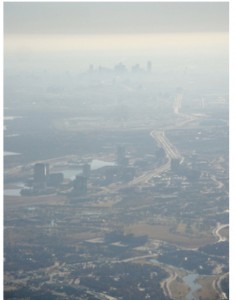 Frustrated that Rick Perry's Texas Commission on Environmental Quality isn't doing enough to end DFW's chronic smog problem, the local "Council Of Governments" has issued a "Request for Information" asking for the public's help in suggesting ways to reduce ozone pollution in North Texas.
Frustrated that Rick Perry's Texas Commission on Environmental Quality isn't doing enough to end DFW's chronic smog problem, the local "Council Of Governments" has issued a "Request for Information" asking for the public's help in suggesting ways to reduce ozone pollution in North Texas.
Please use our Click N' Send E-mail form to make sure they get the message that the public wants:
1) State-of-the-Art pollution controls on huge "point sources" of pollution like the Midlothian cement kilns and East Texas power plants.
2) New pollution control equipment and strategies to reduce the air pollution from the thousands of natural gas facilities mining the Barnett Shale.
3) Inclusion of all trucks and off-road vehicles in the state's vehicle maintenance and inspection program.
You can also add strategies or ideas of your own as well. Just click here, fill out the e-mail and send it in to be counted.
It takes as little as 30 seconds.
BUT YOU ONLY HAVE UNTIL 5 pm FRIDAY, VALENTINE'S DAY.
______________________________________________________________
Rick Perry's TCEQ is so discredited on the matter of DFW smog, local officials usually working in concert with the state agency are now looking elsewhere for help.
Ever since DFW was required to write and submit new clean air plans, The North Central Texas Council of Governments has been the local vehicle used by the state to funnel information, concern, and ideas back and forth.
It was never easy to get Austin's attention or convince the Powers That Be of the need to take bigger clean air measures. It took a decade for Downwinders to get the State to admit that the Midlothian cement plants had a huge impact on local air quality before they were the targets of new controls.
But ever since Rick Perry began running for President in 2010, it's been impossible for Austin toget serious about any DFW clean air plan. For the past four years, TCEQ has claimed that it can reduce air pollution enough by doing nothing.
That strategy has been a dismal failure. New car buying in the middle of the worst economic downturn since the 1930's was the TCEQ clean air plan in 2011. Austin promised that if we just sat back, we'd have the lowest smog levels ever recorded. Instead we had worse air pollution levels than we did five years ago.
This time round, TCEQ is saying a new EPA-mandated low-sulfur gasoline mix in 2017 will be the region's savior for the new clean air plan that's supposed to be successful in reaching the new federal ozone standard of 75 parts per billion in 2018. We're at 87 ppm now – still in violation of the old 1997 standard.
Just watch this new fuel being added to cars and see the ozone numbers drop, TCEQ is saying. No need to put controls on gas facilities, or cement kilns, or power plants. Nothing that would give Rick Perry's opponents on the Right any opportunity to claim he was "anti-bidness."
Even the Council of Governments isn't buying it.
That's why, in their own bureaucratic fashion, this Request for Information that the COG has issued is it's own middle-of-the-road middle finger to TCEQ.
Usually, it would be the state facilitating a discussion of new air pollution control strategies, but since it's obviously not interested, the COG has decided to go its own way. That's how bad things have gotten in Austin – even their most reliable allies in DFW can no longer take them seriously.
It's not clear what will happen to the list of control measures that the Council of Governments is assembling. Some might receive some more official attention, but locals have no authority to write or override Austin's decisions. TCEQ is the only entity that's authorized to submit a new clean air plan to EPA by the June 2015 deadline.
But there are ways to use the useless clean air plans that Austin is submitting. Downwinders' own green cement campaign is a great example.
In 2007, we successfully inserted a voluntary air pollution control strategy into the TCEQ plan revolving around the purchasing of cement from newer cleaner "dry" kilns by local North Texas governments. We then took that "green cement" procurement option and went to Dallas to pass the nation's first green cement ordinance. Then Fort Worth passed it. Then Plano. Then Arlington. Then Denton. Then Dallas County. Then Tarrant County.
Within two years, we had established a de facto moratorium on dirtier "wet kiln" cement within at least a dozen municipal and counties. Combined with federal rule changes, we were able to get all Midlothian wet kilns closed. The last one is being be converted to a dry kiln this year. All while Rick Perry was governor.
The same thing could happen with a good "off-sets" policy for gas facilities if a local city of county could pass a template ordinance showing the way. Currently, most of the gas industry is exempt from being required to "off-set" their air pollution in smoggy "non-attainment" areas like other large industries in DFW. Take away this exemption and you'll see a swift decrease in gas industry air pollution.
It's these kinds of strategies that don't depend on action from Austin that offer the greatest potential for progress this time around.
TCEQ has never written a successful clean air plan for North Texas, and it's not going to start now. But citizens themselves can take their lungs' fate into their own hands and begin to build a system of local measures that can make breathing easier.
______________________________________________________________
CALENDAR AND STATUS REPORT OF DFW'S NEWEST CLEAN AIR PLAN
Reach a 3-year rolling average of no more than 75 ppm of ozone at all 18 DFW area air monitors.
End of an Era: TXI Cement Sold To Martin-Marietta
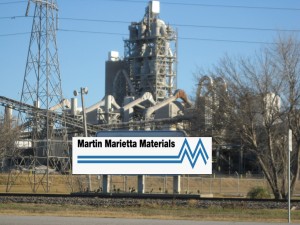 In a $2 billion deal, Raleigh, North Carolina-based aggregate and crushed stone manufacturer Martin Marietta Materials (a separate spin-off on the more well-know aerospace conglomerate) bought Dallas' own TXI Cement, which opened its first cement kiln in Midlothian in 1960.
In a $2 billion deal, Raleigh, North Carolina-based aggregate and crushed stone manufacturer Martin Marietta Materials (a separate spin-off on the more well-know aerospace conglomerate) bought Dallas' own TXI Cement, which opened its first cement kiln in Midlothian in 1960.
This year, that kiln, along with the three other obsolete wet kilns at TXI's Midltohian plant that burned hazardous waste for two decades, is due to be demolished, following the company's corporate demise at the hands of the grandson of its founder. And then, the last remnants of the old TXI will be gone for good.
What does the change in ownership mean for breathers in North Texas?
Martin Marietta has owned and operated cement plants around the US in the past, but they'd divested themselves of these prior to 2014. As of now, the TXI cement plants in Texas and California are apparently the only ones the company owns. There's some speculation that Martin-Marietta bought TXI for its aggregate, stone, and concrete facilities in Texas and California, and will soon seek a buyer for the cement plants it inherited, but doesn't really want.
If that's true, the new owners will act as placeholders of the status quo, not investing in big new capital projects, but also trying not to lose any of the value of the assets they now have by running them into the ground. Martin probably won't look favorably upon attempts to bring smog-reducing modern Selective Catalytic Reduction (SCR) technology to TXI via the next clean air plant for DFW, now due in June of 2015. Not only would the plant be among the first to adopt the technology in the US, (even though SCR has been successfully used in European cement kilns for over a decade now), but it would mean new capital investment and a new learning curve.
Swiss-based Holcim Cement, with a huge plant already in Midlothian and a large manufacturing footprint in the US, was rumored to be one of TXI's suitors before the sale was announced. It could be that Holcim, or another well-established player in the cement industry winds up with the actual kilns in the next year. That could complicate the plant's participation in the new clean air in other ways even if new owners are not as intimidated by the demand for new technology
Politically, it'll be interesting to see which Austin lawyers and lobbyists get the business of the new company. Martin-Marietta owns over 40 facilities in Texas already and is represented by it's own crew. Will TXI's law firm and lobbyists survive the buy-out? There are industry lobbyists that will keep the ball rolling no matter what – the Chemical Council, the Aggregate Association, etc. But in Austin, it's all about relationships, and it's hard to say yet how this Martin's buying of TXI changes any of them.
Maybe the place TXI's absence will be felt the most in in the corridors of power in DFW. TXI was proudly headquartered in Dallas. Ralph Rogers, TXI's founder and patriarch was a driving force in local philanthropy, giving millions to public broadcasting (KERA is housed is housed in the "Ralph Rogers Communications Center") and other non-profits. Besides feeing like he was entitled to use PBS's iconic Big Bird to sell the benefits of burning hazardous waste in 50-year-old cement kilns, the non-profit giving Rogers was responsible for made him a known figure on the Dallas Charitable circuit. In turn, this made it hard for the Powers That Be to criticize Roger's company when it became a waste incinerator.
Locally, the establishment played golf with the Rogers' or attended black tie dinners with them, or helped them lift the oversized scissors at ribbon-cutting ceremonies. But that was old Dallas. Hardly of those relationships survived past Ralph Rogers' death in 1997. His son, Robert, failed to maintain that same high-profile locally, and his grandson Jamie seems totally disinterested in the family business or its legacy of charitable giving.
Now, the move of company headquarters from Dallas to Raleigh will complete the disappearance of the once-mighty TXI on the local scene. They'll still be company representatives at functions, but it won't be the guy who can write the big checks, or who the Mayor had a splendid time with last Saturday at the Club.
The company's local political influence has forever been diminished, and that's a good thing for citizens who are fighting the company to get modern controls like SCR. Now, it's just one more corporate entity with a presence in North Texas. A presence that makes it the single largest air polluter in the region. That's the way Dallas and other downwind cities should have viewed the company all along.
Why Downwinders is involved in the Azle Earthquake Fight
 Downwinders at Risk's Jim Schermbeck was one of several speakers at the public organizing meeting on January 13th in Azle, just northwest of Ft. Worth, that saw the creation of a local citizens group to campaign to end the "human-induced" earthquakes plaguing the area for the past several months.
Downwinders at Risk's Jim Schermbeck was one of several speakers at the public organizing meeting on January 13th in Azle, just northwest of Ft. Worth, that saw the creation of a local citizens group to campaign to end the "human-induced" earthquakes plaguing the area for the past several months.
On Tuesday, he'll climb aboard a bus with Azle area residents and go to Austin to speak before the Texas Railroad Commission about the need to cease operations at local fracking waste injection wells until a Unites States Geological Service study on problem in completed in April.
Why is a group whose stated mission is protecting the DFW airshed getting involved with a fight over injections wells and earthquakes?
1. We were asked to. There just aren't that many groups in Texas that employ someone who knows how to parachute into a community and start an effective campaign from scratch. Downwinders is one of them. When we're asked to help a community we haven't been involved in before, as we were in Frisco, and as we are now in Azle, we think about our own past and the lack of any professional resources on the scene in the early 1990's during our fight with the Midlothian cement kilns. If we can be of some help in assisting people who legitimately need it, we usually don't turn them down.
2. Injections wells can be significant sources of air pollution. These facilities can dispose of 100 to 200 million gallons or more of waste every year. Besides fugitive emissions for unloading and storage, some injection wells also have outdoor pools of waste that systematically evaporate pollutants into the air. Injection wells are known to contribute to air quality problems on the ground similar to those experienced by original Downwinders living near the Midlothian cement kilns when they were burning hazardous waste. It turns out there are downwinders surrounding injection wells too. These well emissions are not only a toxic threat to residents living in the immediate vicinity, but they also contribute to regional smog problems too.
3. A win in Azle could led to saner restrictions on locating injection wells. It looks like the recent "swarm" of earthquakes around Azle are centered between two active injection wells. Why are these wells causing problems but others aren't? And why are injection wells being placed in densely populated areas near lots of water wells and infrastructure? DFW Airport saw earthquakes from their injection well and it got closed. Azle residents just want the same respect as American Airlines jets. Are there places in Texas where injections wells shouldn't be located? Yes. Like airports and places where people live near-by. Is it possible to use the Azle fight to better articulate that, regionally or even statewide? Yes. And that would be a good thing.
4. Azle represents an opportunity to organize and win deep behind enemy lines. Azle is in the heart of the Barnett Shale. It's already surrounded by wells and pipelines and compressors, and yet area residents know the shaking that's disrupting their lives is directly linked to fracking itself. This is a revolt of the already-gassed masses, something the western part of the Metromess hasn't seen. It's also true that Azle is prime tea-party GOP territory. Making alliances there helps give lie to the myth that environmental health is only something Democrats and tree-huggers are concerned about. Azle residents can't be easily dismissed as Greenpeace types. You can already see the worry from elected officials over the rise of these new critics. Railroad Commission special meetings. The hiring of a new state seismologist. A new legislative committee on quakes. All in less than a month. This ain't Austin. It's not even Dallas.
That's why we're getting on the bus come Tuesday.
Physicians for Social Responsibility Talk This Thursday Night
DFW has a lot of things, but one thing we do not have is a group of medical professionals who speak out for environmental health when it's threatened by pollution or other human-made disasters. Nationally, the group Physicians for Social Responsibility (PRS) has filled this role for over 50 years now. Founded in 1961 to make the medical case against a "winnable" nuclear war, the organization has morphed into a strong voice for clean air and water from a public health point of view.
Despite being a national center of medical research and care, DFW doesn't have a local chapter of PSR. But this Thursday, Chris Masey, the Austin-based Texas Director of the group will be in Dallas to talk about their connection to current energy and environmental fights, including the one against aging East Texas coal plants that were the subject of a Dallas County Medical Society petition to the Texas Commission on Environmental Quality.
His visit is sponsored by Dallas Interfaith Power and Light. Its scheduled for this Thursday beginning at 7 at the White Rock Methodist Church on Oldgate Lane. Here's what their blurb says about the talk:
Chris will speak about air quality as a crucial key to human health including fossil fuels background and information, specific toxic emissions, air as a carcinogen, climate disruption, and the shifting patterns of infectious diseases. Chris’s lecture will also include information about Texas PSR, and ongoing advocacy efforts to phase out and close coal-fired power plants and to advocate for stricter carbon emission standards.
More about our speakers: Chris Masey, MBA, is a eighteen-year environmental professional who has worked on a diverse set of projects throughout Texas focusing on public health, conservation, land stewardship, alternative energy sources, recycling, and environmental and solid waste planning. During the last two years, Chris has proudly helped guide Texas PSR (formerly Austin PSR) to become the largest environmental advocacy group led by healthcare professionals in Texas! Chris’ dedication to environmental sustainability is grounded in his love of Texas and the desire for his family to continue to enjoy clean air, clear water, and wide-open spaces.
If you're a medical professional who's interested in helping out citizens in need, or you know someone who fits thst description, please consider attending this Thursday's meeting. There's really no excuse for a metropolitan area the size of DFW not to have a cadre of concerned doctors and nurses who can speak put against fracking close to homes or burning plastic in cement kilns, or just confirm for some of our more aggressively ignorant elected officials that indeed, smog and lead are bad for people. With any luck, perhaps Chris Masey's appearance here this week can begin a conversation that leads to such an effort. It is way overdue. See you there.
Follow-Up Study Confirms Lower Birth Weight Babies Around Fracking Sites
 A 2012 study by a Cornell graduate student Elaine Hill that found a 25% increase in low-birth weight babies within 1.5 miles (7920 feet) of a gas fracking sites in Pennsylvania got a boost from a follow-up study previewed over this last weekend at a conference in Philadelphia.
A 2012 study by a Cornell graduate student Elaine Hill that found a 25% increase in low-birth weight babies within 1.5 miles (7920 feet) of a gas fracking sites in Pennsylvania got a boost from a follow-up study previewed over this last weekend at a conference in Philadelphia.
Janet Currie of Princeton University, Katherine Meckel of Columbia University, and John Deutch and Michael Greenstone of the Massachusetts Institute of Technology also looked at Pennsylvania birth records and found the risk of low-weight births increased by 50% within 2. 5 kilometers (8125 feet) of a fracking site. That's over 7 times the distance of the recent 1500 foot buffer zone between homes and drilling pads passed by the City of Dallas last month.
This rate was constant for both households with their own water wells and municipal water system users, seemingly ruling out water contamination as a cause. Air, noise and light pollution are now the suspected culprits.
This second study was specifically designed to address critics of Hill's previous work:
"….they built on the work of Elaine Hill, a PhD student at Cornell University who sparked controversy in 2012 with a study showing that infants born near fracked gas wells had more health problems than infants born near sites that had merely been permitted for fracking. One criticism of Hill's study was that fracking activity might change the demography of an area, attracting more mothers who are likely to give birth to infants with health problem.
The new research addresses such concerns by following a constant group of mothers who had children both before and after the onset of fracking, and by controlling for geographical differences in mothers' initial health characteristics. It seeks to achieve the rigor of a controlled experiment by focusing on mothers who, due to their locations and the dates of their pregnancies, were effectively selected at random to be exposed to fracking.
The study is expected to be accepted for publication sometime this Spring after being peer-reviewed.
Coming to A Cement Plant Near You? Burning Fracking Fluid
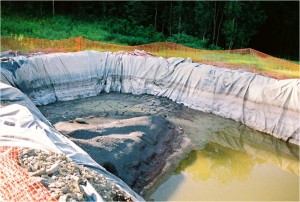 A Canadian LaFarge Cement plant wants to start using fracking fluid to replace fresh water it uses in its manufacturing process.
A Canadian LaFarge Cement plant wants to start using fracking fluid to replace fresh water it uses in its manufacturing process.
The company's Brookfield plant in Nova Scotia is an ancient "wet kiln" that uses approximately 35 million liters of water from a near-by lake to produce cement. Fracking fluid that has been run through a reverse osmosis filtering process would be used as a parital substitute for this fresh water.
According to the local newspaper account, a LaFarge PR spokesman is quoted as saying “It’s safe enough to drink. The contaminants have been removed and the recycled waste water exceeds government guidelines to be released in the environment.”
But funny thing. Despute that assurance of safety, when the company ran a full page ad announcing its plans to use waste water, it forgot to mention that it was waste fracking fluid. Maybe because there's a moratorium on fracking in the Province while a review of its safety and public health impacts are investigated.
Local municipal Council Member Doug MacInnes said he spoke to the LaFarge plant manager about the ad.“He explained to me that it was worded that way so that it wouldn’t get the public upset." According to the LaFarge manager, "I think there is a negative connotation with fracking."
So where is the waste fracking fluid coming from? From two local holding ponds that have been containing the leftovers of three wells way back in 2007 and 2008. About 14 million litres of fresh water was used. When this water was regurgitated by the wells it was poured into the ponds. Many observers believe that although this first step is only a pilot test, LaFarge wants to begin importing fracking fluid from Canada's large oil and gas plays.
When it was burning hazardous wastes in its own wet kilns in Midlothian from 1986 to 2008, TXI Cement also charged companies for disposing of their industrial waste waters, which often contained Volatile Organic Compounds (VOCs), heavy metals, chlorine and other contaminants. Back then, it was called "recycling" and was defended by TXI as a way to reduce fresh water use, and costs. TXI used the "Long, Hot and Good For America" argument it always used to defend the burning of waste – that the high temperatures of the kiln destroy all the bad stuff. Only that's not true. Metals don't burn. Chlorine doesn't burn. And Dioxin can actually be created when plastics are burned.
And there was another problem unique to the disposal of wastewater. The contaminants, especially the VOCs, were being lost to the atmosphere long before the water reached the plant's kilns with their 2500 degree temperatures – the rising heat stripped the pollutants out of the water and sent them up the stacks, causing an increase in pollution. For these reasons, EPA forced TXI to quit using industrial wastewater as a substitute for fresh water even before the wet kilns shut down permanently in 2008 and waste-burning was halted.
With fracking waste water, you get all these kinds of pollutants plus the added threat of radioactivity, of which there is no mention in any of the coverage about the LaFarge proposal. "Natural radioactive elements" as well as ones used in the drilling process have been known to contaminate fracking waste. Reverse osmosis won't be able to fix that.
We've written about idea of oil and gas fracking fluid flowing downhill to the cement plant industry – the least regulated option – for disposal, most recently when it came up in Saudi Arabia. Now it's jumped the pond and has landed in North America. How long do you think it'll be before you see a cement plant near or in a US shale play that will propose the same thing?
One of the practical concerns of citizens over the plans of the LaFarge plant is the effect corrosive fracking fluid that's full of salt has on an industrial process dependent until now on fresh water.
The local Colchester County Council. is planning to send a letter of concern to Lafarge, the minister of Environment, and the local Department of Environment office. Last summer, council rewrote its sewage use bylaw and rejected an application by a local firm to dispose of treated frack waste through the municipal sewer system because of potential dangers to the environment. That same firm is the one that says it will filter the fracking fluid before sending it to LaFarge.

